In this article we will discuss the power quality terms. The power quality is of utmost importance for reliable operation of the electrical equipment. It is desirable that the electrical machines always get the sinusoidal supply. The deviation in the sinusoidal waveform shows the power quality issues.
Power Quality(PQ) can be defined as the quality of electrical power during any abnormal behavior on any power system arising in the form of voltage or current, which affects the normal operation of electrical or electronic equipment.
Reasons for Power Quality Issues:
- The increasing emphasis on overall efficiency of power system has increased the application of devices such as high-efficiency, adjustable-speed motor drives and shunt capacitors for power factor correction to reduce losses which is resulting in increasing harmonic levels on power systems.
The new generation load equipment with power electronic-based controls and power electronic devices is more sensitive to power quality variations.
All the power quality issues are divided into following categories.
- Transients
- Long-Duration Voltage Variations
- Short-Duration Voltage Variations
- Voltage Imbalance
- Waveform Distortion
- Voltage Fluctuation
- Power Frequency Variations
1. Transients
Transients have been used since long time in the analysis of power system variations to denote undesirable events. The transients in the supply voltage or current deteriorates the power quality(PQ).
Types of transients
Impulsive Transients
These are sudden, non-power frequency change in the steady-state condition of voltage, current, or both that is unidirectional in polarity. Impulsive Transients have very less rise and very large decay times. The transients deteriorates the power quality, and can cause failure of insulation of electrical system.
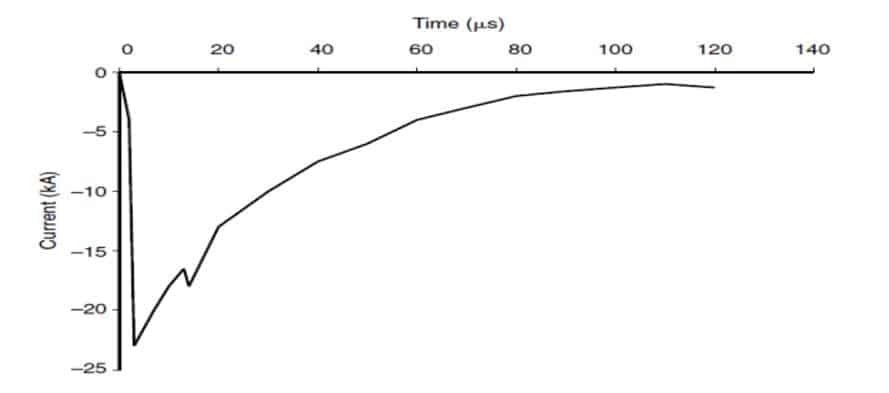
Oscillatory Transients
A sudden, non-power frequency change in steady-state condition of voltage, current, or both that includes both polarities.
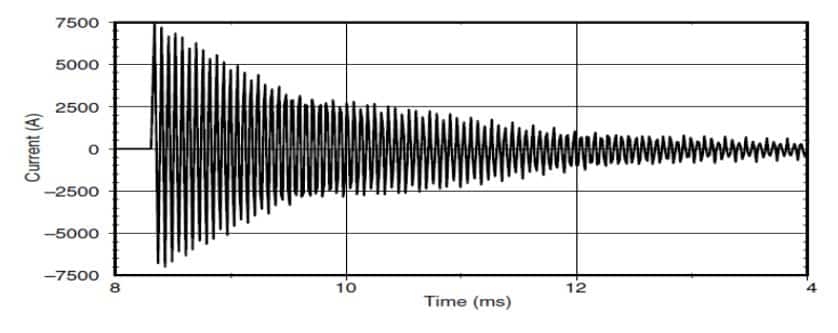
2. Long Duration Voltage Variations
The voltage variation Occurs whenever voltage RMS value deviates for duration more than 1 minute.
- Under-Voltage: At the power frequency, decrease in the ac RMS voltage to less than 90 percent.
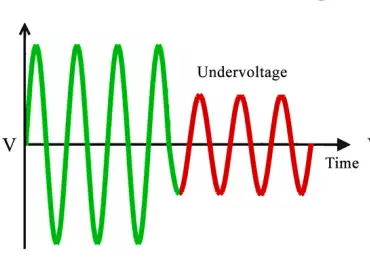
- Over-Voltage: Increase in the ac RMS voltage greater than 110 percent at the power frequency
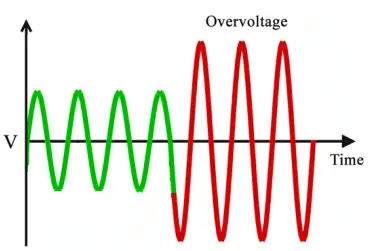
- Sustained Interruptions: When supply voltage becomes zero for a period in excess of 1 minute.
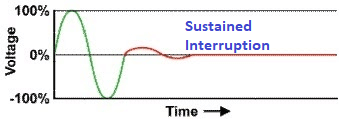
3. Short Duration Voltage Variations
Variation in voltage occurs whenever voltage rms value deviates for duration less than 1 minute.
- Interruption: For a period less than 1min, when supply voltage or load current decreases to less than 0.1 pu. For example, power system faults and control malfunctions cause power interruption.
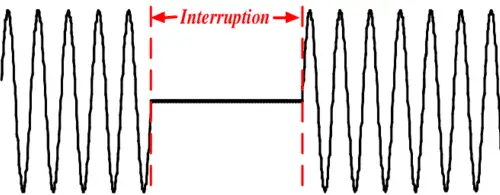
- Sags(dips): At power frequency, sudden decrease in rms voltage or current between 0.1 and 0.9 pu for durations from 0.5 cycle to 1 minute.
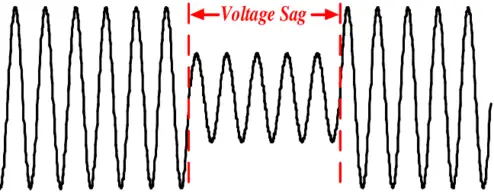
- Swells: At power frequency, sudden increase in rms voltage or current between 1.1 to 1.8 pu for durations from 0.5 cycle to 1 min.

4. Voltage Imbalance
The voltage imbalance is the maximum deviation from the average of the 3-phase voltages or currents divided by average of the 3-phase voltages or currents, expressed in percent.
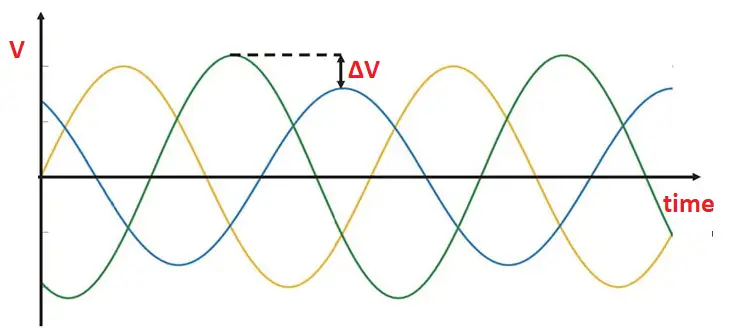
5. Waveform Distortion
The deviation in the steady state from an ideal sine wave of power frequency.
- DC Offset: DC Current or Voltage presence in an AC power system.
- Harmonics: Sinusoidal voltages or frequencies having frequencies that are integer multiples of the fundamental frequency. Examples of sources: non-linear loads
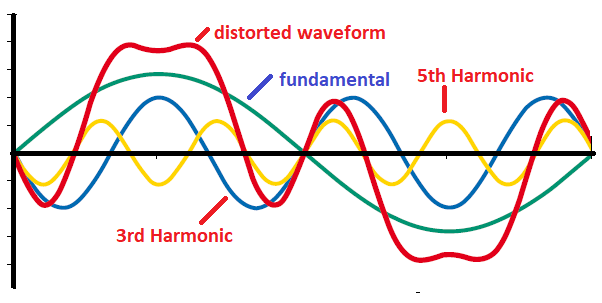
- InterHarmonics: Currents or Voltages having frequency components of non-integer multiples of fundamental frequency (eg. 50 or 60Hz).
- Notching: Notching in waveform occurs when current commutates from one phase to another. Therefore, it cause a periodic voltage disturbance. The example of notching is commutation of SCRs in DC drive.
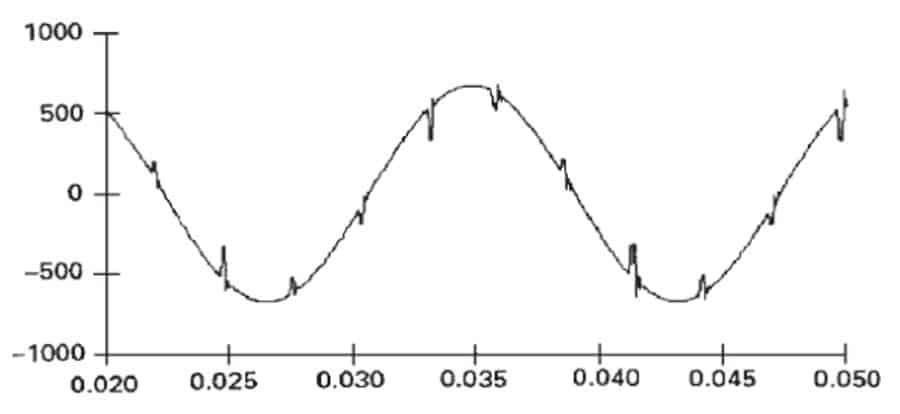
6. Voltage Fluctuation
Systematic or series of random voltage variations of magnitude ranging from 0.9 to 1.1 pu. Flicker is the term derived from the impact of voltage fluctuation on lamps.
7. Power Frequency Variations
Deviation of fundamental frequency of the power system from its specified nominal value (50 or 60 Hz).
POWER QUALITY TERMS:
CBEMA curve:
Set of curves which represent the withstanding capabilities of computers in terms of magnitude and duration of the voltage disturbance. Computer Business Equipment Manufacturers Association (CBEMA) has developed it. It is considered standard for measuring performance of all types of equipment and power systems.
Crest Factor
Many power quality monitoring instruments report a value representing the ratio of the crest value of the measured waveform to the root mean square of the fundamental.
Critical load:
Devices whose failure to operate satisfactorily jeopardizes the health or safety of personnel which results in damage to user.
Distortion:
Any unwanted deviation from sine wave for an AC quantity. The modern electrical loads are non linear type and deteriorates the power quality because of harmonic distortion.
Dropout Voltage:
Voltage at which device will fail to operate.
Electromagnetic Compatibility (EMC):
A device or system’s ability to function in its electromagnetic environment satisfactorily without any disturbances.
Transient Fault:
Short circuit on the power system generally induced by lightning, which can be cleared by momentarily interrupting the current.
Ferro-Resonance:
Irregular type of resonance that involves the nonlinear characteristic of ferrous inductors, always undesirable when occurs in power system.
Frequency Deviation:
An increase or decrease in the power frequency whose duration can be from several cycles to several hours.
Harmonic content:
The quantity other than the fundamental component of an alternating quantity.
Harmonic filter:
Devices used in power system for filtering one or more harmonics from the power system. Mostly are passive combinations of inductors, resistors, and capacitors.
Inverter:
Power electronic device that helps in converting direct current to alternating current at power frequency.
Islanding:
Condition in which distributed generation is isolated on portion of load served by the utility power system.
Linear Load
Electrical load presenting constant load impedance to the power source throughout the cycle of applied voltage.
Non-linear load:
Electrical load that draws discontinuous current or whose impedance varies throughout the cycle of input ac voltage.
Pulse width modulation:
General technique used in inverters to create an ac waveform to produce varying width pulses by controlling the electronic switch. Minimizes power frequency harmonic distortion in some applications.
Total Harmonic Distortion (THD):
It is the ratio of the root mean square of the harmonic content to the RMS value of the fundamental quantity, expressed in percentage of the fundamental.
Read Next: